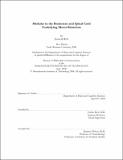Modules in the brainstem and spinal cord underlying motor behaviors
Author(s)
Roh, Jinsook
DownloadFull printable version (2.152Mb)
Other Contributors
Massachusetts Institute of Technology. Dept. of Brain and Cognitive Sciences.
Advisor
Emilio Bizzi.
Terms of use
Metadata
Show full item recordAbstract
Previous studies using reduced or intact animal preparations suggested that coordinated movements can be generated by appropriate combinations of muscle synergies controlled by the nervous system. However, which areas of the central nervous system are responsible for structuring and combining muscle synergies remains an open question. In my thesis, I have addressed the question whether the brainstem and spinal cord are involved in structuring and combining muscle synergies in order to execute a range of natural movements. The strategy to investigate this question was to analyze the electromyogram (EMG) data recorded from the leg muscles during frog motor behaviors before and after neuronal transection. In my two sets of experiments, EMGs were recorded before and after transection at the level of the caudal end of the third ventricle and at the level of the caudal end of the pons in two groups of frogs. When the section was at the level of rostral midbrain, movements such as jumps, swims, kicks, and walks could be performed by the animals. In contrast, when the transection was at the level of rostral medulla, only a partial repertoire of natural movements could be evoked. Systematic analysis of muscle synergies in these preparations found two different types of synergies: (1) synergies shared by intact animals and animals with transection, and (2) synergies specific to individual motor behaviors. In addition, almost all synergies utilized in the execution of natural motor behaviors remain invariant after transection at the level of the caudal end of the third ventricle or at the level of the caudal end of the pons. The results suggest the following: (cont.) (1) the neural network within the brainstem and spinal cord are necessary and sufficient in combining muscle synergies in the organization of natural movements, and (2) the neural circuitries within the medulla and spinal cord are sufficient to structure the repertoire of muscle synergies in natural motor behaviors. Overall, the major findings of this study indicate how the neural divisions in the CNS are functionally differentiated for structuring and combining modules in execution of natural movements.
Description
Thesis (Ph. D.)--Massachusetts Institute of Technology, Dept. of Brain and Cognitive Sciences, 2008. This electronic version was submitted by the student author. The certified thesis is available in the Institute Archives and Special Collections. Includes bibliographical references (leaves 89-95).
Date issued
2008Department
Massachusetts Institute of Technology. Department of Brain and Cognitive SciencesPublisher
Massachusetts Institute of Technology
Keywords
Brain and Cognitive Sciences.